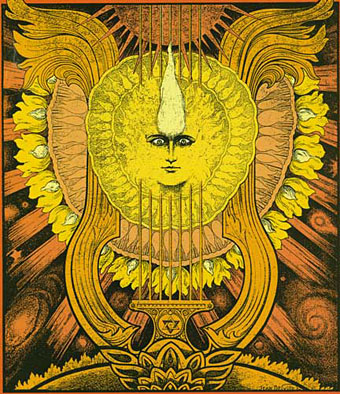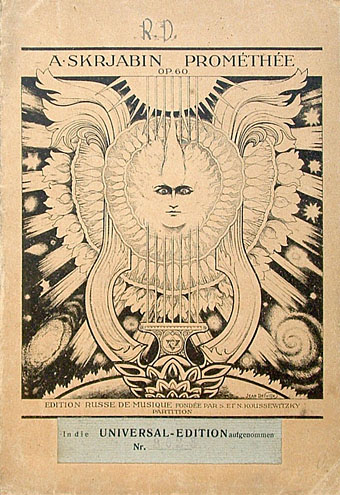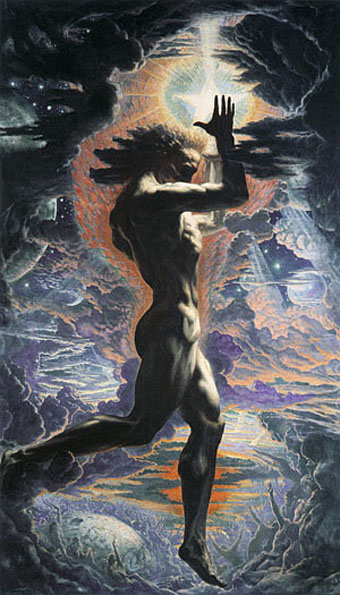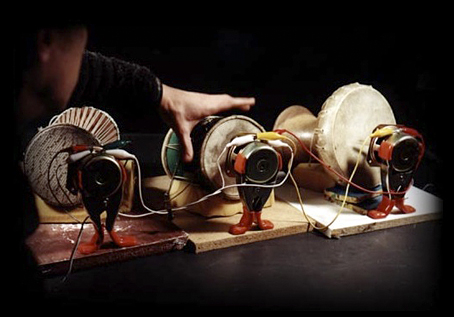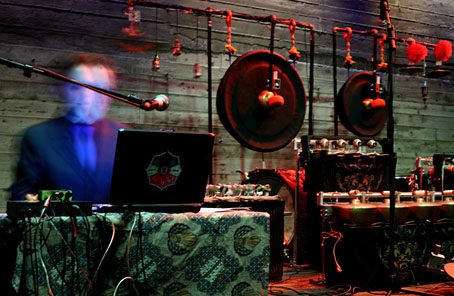Dream sleeves: John Walsh on how a 40 year old idea could save the music industry
Category: {music}
Music
Delville, Scriabin and Prometheus
Another striking design found by chance. Symbolist artist Jean Delville (1867–1953) created this sheet music title page for Promethée by Scriabin in 1912, and the pair are well-matched given their shared predilection for mysticism (Theosophy in Delville’s case). Delville had also dealt with Prometheus in a typically dramatic, if sexless, picture a few years earlier (below). Once again it’s unfortunate that one of the really great artists of the Symbolist period is so poorly-served by the web that one has to discover his work by accident. There’s a dedicated site here but the gallery pages are only harvesting what’s already scattered around. Delville had a long and consistently high-quality career; he deserves better.
Prometheus (1907).
Update: Dave C reminds us of another Delville site with a better selection of pictures including a photo of the artist at work.
Previously on { feuilleton }
• The faces of Parsifal
• Masonic fonts and the designer’s dark materials
• Angels 4: Fallen angels
Rashied Ali, 1935–2009

The death this week of guitar pioneer Les Paul is already receiving considerable attention; less will be given to the passing of drummer Rashied Ali. The latter means more for me as a musician since I’m listening to his work all the time. Ali famously (and to some, controversially) replaced drummer Elvin Jones as John Coltrane’s drummer of choice from 1966 onwards, and Ali’s revolutionary free style enabled Coltrane to voyage even further out with his stream-of-consciousness sax playing. Ali’s playing supports all of Coltrane’s later recordings, including their extraordinary duet album Interstellar Space (recorded in the ’60s but not released until 1974). Following Coltrane’s death in 1967, Ali played on a number of albums by the fantastic Alice Coltrane, and while this period inevitably overshadows any appraisal of his work, his career continued to develop to the present day.
If you’re unused to the “formlessness” of free jazz, Interstellar Space can be a forbidding region until you attune yourself to its rarefied atmospheres. Alice Coltrane’s A Monastic Trio, recorded shortly after her husband’s death, is less challenging and a beautiful tribute to John Coltrane from his wife, friends and collaborators. With Jimmy Garrison on bass, Pharoah Sanders on sax, Alice playing harp and piano, and Ali drumming on five of its six tracks, its a perfect introduction to Ali’s work, and, by extension, to some of the finest music of the last century.
Previously on { feuilleton }
• John Coltrane’s Giant Steps
• Alice Coltrane, 1937–2007
Automates Ki
Following the post last week about the Gamelatron, Masha left a comment referring me to the similar, if less harmonious, Automates Ki systems of Canadian composer Maxime De La Rochefoucauld who describes his constructions as “musical robots activated by inaudible frequencies”. He also says:
Ki is a japanese concept : roughly, it is the invisible vital energy that makes things move. I use this word as an allegory for the energy that animates my automatons. The listener and spectator only hears and sees the consequences of this vibration. In this context, my Automates Ki are “spokespersons” for the vibration instead of invented musical instruments, since to build them I use previously created instruments gathered from various countries.
For several years I have worked on a system of my own invention that animates the automatons, producing a music centered on percussion. The Systeme Ki™ transforms inaudible low-frequency modulations into an acoustic phenomenon.
The Automates Ki comprises a speaker joined to a musical instrument. A pliable firing pin is set on the speaker. The firing pin, when animated by the vibration of the speaker, hits the acoustic instruments (drums, cymbals, strings instruments) in an oscillating manner.
There’s a website devoted to these works, and a MySpace page, but the best appraisal can be had by viewing some of the composer’s YouTube clips.
Previously on { feuilleton }
• The Gamelatron
• Metronomes
• Cristalophonics: searching for the Cocteau sound
• Max Eastley’s musical sculptures
• The Reactable
• The Ondes Martenot
The Gamelatron
The Gamelatron at Galapagos Art Space March 2009. Photo by Gisella Sorrentino.
A laptop-controlled gamelan orchestra by Zemi17 aka A. Taylor Kuffner. See it in operation here. (Is it Gamelatron or GamelaTron? Their spellings differ…)
The GamelaTron is the fruit of a collaboration between The League of Electronic Musical Urban Robots (LEMUR) and the composer Zemi17: A. Taylor Kuffner.
Modeled after traditional Balinese and Javanese gamelan orchestras, the GamelaTron is an amalgamation of traditional instruments with a suite of percussive sound makers. MIDI sequences control 117 robotic striking mechanisms that produce intricately woven and rhythmic sound. Performances follow an arc similar to classic Indonesian gatherings, where stories from great epics, such as the Ramayana, are told and settings given in words that are continued in music.
Sounds overly-mechanical to my ears but then that’s probably inevitable given the way the instruments are being controlled. The classic Nonesuch Explorer recordings of Javanese and Balinese gamelan orchestras follow less rigid rhythmic patterns. And being recorded outdoors the Indonesian music is augmented by background atmospheres from birds and insects.
For more variations on the gamelan theme, there’s 23 Skidoo’s Urban Gamelan album (recently reissued) and the many chiming electronic exercises by Paul Schütze.
Previously on { feuilleton }
• Paul Schütze online
• Metronomes
• Cristalophonics: searching for the Cocteau sound
• Max Eastley’s musical sculptures
• The Reactable
• The Ondes Martenot

